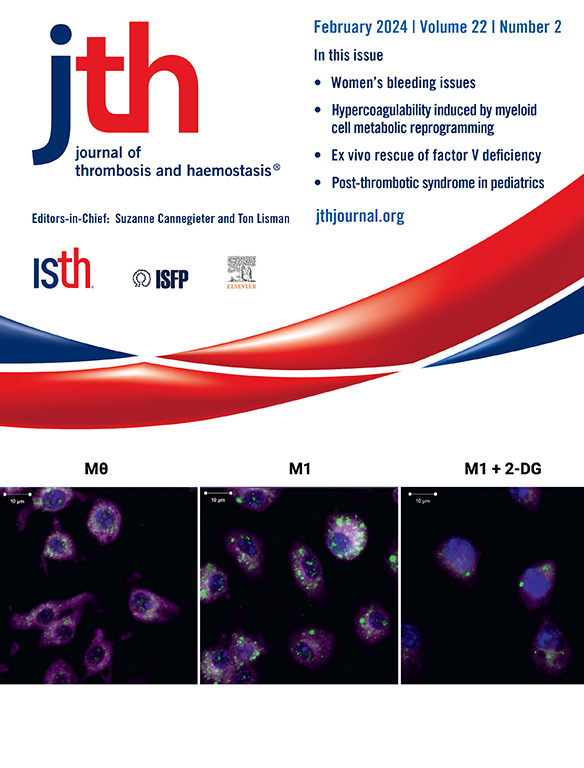Basics of diagnosis and treatment of venous thromboembolism
IF 5.5
2区 医学
Q1 HEMATOLOGY
引用次数: 0
Abstract
Venous thromboembolism (VTE), comprising deep vein thrombosis and pulmonary embolism (PE), is common and associated with significant morbidity and mortality. The symptoms and signs of VTE are nonspecific. Well-established integrated diagnostic strategies combining clinical probability scores and D-dimer are used to identify patients with a low probability of VTE, where the diagnosis can be safely excluded without imaging. In patients with confirmed VTE, anticoagulation is the mainstay of treatment. However, patients with high-risk features at presentation may benefit from advanced reperfusion therapies such as thrombolysis and/or interventional approaches to reduce early mortality and/or long-term morbidity. The advent of direct oral anticoagulants has greatly simplified the treatment of VTE for most patients, with a persisting role for low molecular weight heparin and vitamin K antagonists in select patient groups. Following an initial 3 to 6 months of anticoagulation, those with major transient provoking factors can safely discontinue anticoagulation. Balancing the risk of recurrent VTE and bleeding risk is central to decisions regarding long-term anticoagulation, and patients should be included in shared decision-making. Assessment and recognition of common long-term complications such as postthrombotic syndrome and post-PE syndrome are also essential, given they are associated with significant adverse impact on long-term quality of life, with a significant risk of mortality associated with the less frequent complication of chronic thromboembolic pulmonary hypertension. This review provides a basic overview and framework for the diagnostic approach to deep vein thrombosis and PE, risk stratification of confirmed diagnoses, and management.
特邀综述:静脉血栓栓塞的诊断和治疗基础。
静脉血栓栓塞(VTE),包括深静脉血栓形成(DVT)和肺栓塞(PE)是常见的,并与显著的发病率和死亡率相关。静脉血栓栓塞的症状和体征是非特异性的。采用完善的综合诊断策略,结合临床概率评分和d -二聚体,识别低概率VTE患者,无需影像学检查即可安全排除。在确诊的静脉血栓栓塞患者中,抗凝治疗是主要的治疗方法。然而,在发病时具有高危特征的患者可能受益于先进的再灌注治疗,如溶栓和/或介入治疗,以减少早期死亡率和/或长期发病率。直接口服抗凝剂(DOACs)的出现大大简化了大多数患者的静脉血栓栓塞治疗,低分子肝素(LMWH)和维生素K拮抗剂(VKAs)在特定患者组中持续发挥作用。在最初的抗凝治疗三到六个月后,那些有主要诱发因素的患者可以安全地停止抗凝治疗。权衡静脉血栓栓塞复发风险和出血风险是长期抗凝治疗决策的核心,患者应参与共同决策。评估和识别常见的长期并发症(如血栓后综合征和PE后综合征)也很重要,因为它们对长期生活质量有显著的不利影响,并且与慢性血栓栓塞性肺动脉高压并发症的发生率较低相关的死亡风险显著。本文综述了DVT和PE的诊断方法、确诊诊断和治疗的风险分层的基本概况和框架。
本文章由计算机程序翻译,如有差异,请以英文原文为准。
求助全文
约1分钟内获得全文
求助全文
来源期刊
CiteScore
24.30
自引率
3.80%
发文量
321
审稿时长
1 months
期刊介绍:
The Journal of Thrombosis and Haemostasis (JTH) serves as the official journal of the International Society on Thrombosis and Haemostasis. It is dedicated to advancing science related to thrombosis, bleeding disorders, and vascular biology through the dissemination and exchange of information and ideas within the global research community.
Types of Publications:
The journal publishes a variety of content, including:
Original research reports
State-of-the-art reviews
Brief reports
Case reports
Invited commentaries on publications in the Journal
Forum articles
Correspondence
Announcements
Scope of Contributions:
Editors invite contributions from both fundamental and clinical domains. These include:
Basic manuscripts on blood coagulation and fibrinolysis
Studies on proteins and reactions related to thrombosis and haemostasis
Research on blood platelets and their interactions with other biological systems, such as the vessel wall, blood cells, and invading organisms
Clinical manuscripts covering various topics including venous thrombosis, arterial disease, hemophilia, bleeding disorders, and platelet diseases
Clinical manuscripts may encompass etiology, diagnostics, prognosis, prevention, and treatment strategies.

 求助内容:
求助内容: 应助结果提醒方式:
应助结果提醒方式:


